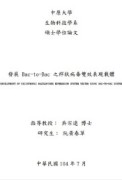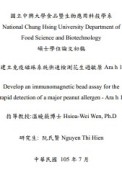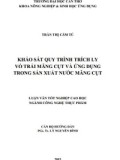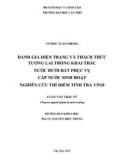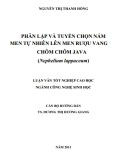


|
|
|
Tác giả: Nguyen Hoang Xuan Thao; 吳宗遠 博士 (người hướng dẫn khoa học). |
|
中原大學 . Năm: 2014. |
|
Mô tả: 60Tr, kích thước: 30cm. Số định danh: 660.6/ Th108. Vị trí: Phòng đọc. |
|
Tóm tắt: Baculoviruses are one of the most studies insect viruses both in basic virology research and in biotechnology applications. This insect viruses based baculovirus expression vector system (BEVS) is an important tool for molecular biology and widely used in insect cells. Development of a shuttle baculovirus expression vector which can function in both the mammalian cell as well as in insect cell would have a significant advantages. We had cooperated an internal ribosome entry site (IRES) in to the baculovirus genomes and generated a bicistronic baculoviruses expression vector that can express two genes simultaneously. In this project, we attempt to construct a baculovirus vector with an IRES based bicistronic expression vector which using Bac-to-Bac system. The Bac-toBac system bring more benefits than the traditional methods using homologous recombination in insect cells. Bac-to-Bac plasmids: pFastBac1-Polh-MCS-Lir-DsRed2 had been successfully generated. Such IRES-based Bac-to-Bac BEVS will facilitate rapid and efficient generation of recombinant baculoviruses: time saving expression bacmid, one-step purification and amplification, rapid and simultaneous isolation of multiple recombinant viruses as well as titer determination |
|
Tác giả: Nguyen Thi Hien; 溫 曉 薇 博士 (người hướng dẫn khoa học). |
|
National Chung Hsing University. Năm: 2016. |
|
Mô tả: 74Tr, kích thước: 30cm. Số định danh: 633.36893/ H302. Vị trí: Phòng đọc. |
|
Tóm tắt: Peanut plays an important role in food allergy because only small amounts of peanut proteins can induce severe allergic reactions, and the Ara h 1 is a major allergen. There is no effective treatment for food allergy and the only way is to avoid specific allergens in food. Therefore, a method to detect peanut allergen is necessary. The magnetic beads are an efficient tool to enhance sensitivity by capturing and isolating target molecules from samples. Firstly, crude peanut proteins were obtained from defatted peanut and then precipitated at higher concentrations of ammonium sulfate (70-100%). Subsequently, Ara h 1 was purified in a HiTrap Q HP with a linear salt gradient (0 - 1 M NaCl). Furthermore, three antibodies against Ara h 1 were produced, by immunizing rabbits with 2 immune-dominant epitopes of Ara h 1 and pure Ara h 1 whole protein. Epitope-L (KSSPYQKKTENPCAQR) was from the leader peptide region of Ara h 1, while Epitope-M (SNREVRRYTARLKEG) was from the core region of Ara h 1. Both anti-Ara h 1 antibodies and anti-Epitope-M antibodies have no cross-reactivity with other peanut proteins or proteins from 10 nuts and seeds; while anti-Epitope-L antibodies displayed the reactivity with proteins from almond, macadamia, cashew, flax, and rapeseed. Therefore, anti-Ara h 1 antibody was conjugated to the surface of immunomagnetic beads (IMBs) to capture the Ara h 1 in samples, and anti-Epitope-M Ab was used as the detection antibody to react with protein A-HRP conjugate. Because of 96.3 % of antibody conjugation, 100 g/mL anti-Ara h 1 Ab was selected to be coated on the surface magnetic beads. The dilution of detection antibody was 1/10,000 due to the high optical density in the presence of the allergen and low blank signals. Furthermore, the specificity of the developed assay was testified by analyzing various nuts and seeds. The specificity of immunomagnetic beads assay was highly specific for Ara h 1 with no cross-reactivity. The developed assay allowed the quantification of Ara h 1 between 25 and 200 g/ml with a limit of detection of 14 g/ml. For the detection of Ara h 1 in commercial oil products, three oil among six specimens contained Ara h 1. Therefore, this developed assay would be a rapid method for detecting the major peanut allergen- Ara h 1 in oil samples. |
|
Tác giả: Trần Thị Cẩm Tú. PGS. TS. Lý Nguyễn Bình (người hướng dẫn). |
|
Trường Đại học Cần Thơ. Năm: 2015. |
|
Mô tả: 110Tr. Kích thước: 30cm. Số định danh: 663.6 T500 |
|
Mục tiêu nghiên cứu: Nghiên cứu thực hiện nhằm mục tiêu xác định các thông số tối ưu cho quá trình trích ly vỏ trái măng cụt và ứng dụng vào sản xuất nước măng cụt, đồng thời khảo sát sự biến đổi của một số chất dinh dưỡng và có hoạt tính sinh học (polyphenol, hoạt tính chống oxy hóa, vitamin C) trong quá trình chế biến. |
|
Tác giả: Vương Tuấn Phong. PGS. TS. Nguyễn Hiếu Trung (người hướng dẫn). |
|
Trường Đại học Trà Vinh. Năm: 2015. |
|
Mô tả: 82Tr. Kích thước: 30cm. Số định danh: 333.91 Ph431 |
|
Mục tiêu nghiên cứu: - Xác định hiện trạng khai thác sử dụng nước dưới đất cho sinh hoạt của các hộ dân cư trong thành phố Trà Vinh - Đánh giá nhu cầu sử dụng nước cấp của người dân ở TP. TV - Xác định các thách thức về lượng và chất trong khai thác nước dưới đất phục vụ cho sinh hoạt trong TP.TV - Đề xuất giải pháp ứng phó với các thách thức - Xác định các nguồn có thể cung cấp nước sinh hoạt cho các hộ dân cư trong tỉnh Trà Vinh |
|
Tác giả: Nguyễn Thị Thanh Hồng; TS. Dương Thị Hương Giang (người hướng dẫn khoa học). |
|
Trường Đại học Trà Vinh. Năm: 2013. |
|
Mô tả: 113Tr. Kích thước: 30cm. Số định danh: 660.6 H445. Vị trí: Phòng đọc. |
|
Mục tiêu của luận văn: Tìm ra dòng nấm men tự nhiên có khả năng lên men mạnh thích hợp cho quá trình sản xuất rượu vang chôm chôm với chất lượng cao và hiệu quả. |





